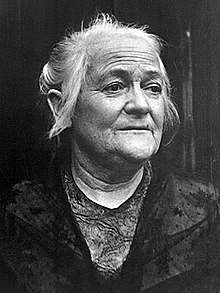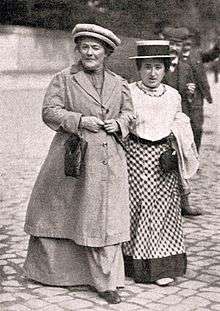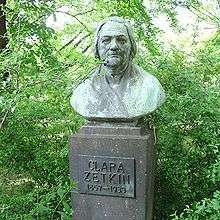Clara Zetkin
Clara Zetkin (/ˈzɛtkɪn/; German: [ˈtsɛtkiːn]; née Eißner [ˈaɪsnɐ]; 5 July 1857 – 20 June 1933) was a German Marxist theorist, activist, and advocate for women's rights.[1]
Clara Zetkin | |
|---|---|
 Clara Zetkin (c. 1920) | |
| Born | Clara Josephine Eißner 5 July 1857 Wiederau, Kingdom of Saxony, German Confederation |
| Died | 20 June 1933 (aged 75) Arkhangelskoye, near Moscow, Russian SFSR |
| Nationality | German |
| Other names | Klara Zetkin |
| Occupation | Politician, peace activist and women's rights activist |
| Political party | SPD (until 1917) USPD (1917–1922; Spartacus wing) KPD (1920–1933) |
| Partner(s) | Ossip Zetkin (1850–1889) Georg Friedrich Zundel (1899–1928) |
| Children | Maxim Zetkin (1883–1965) Konstantin "Kostja" Zetkin (1885–1980) |
| Parent(s) | Gottfried Eißner Josephine Vitale/Eißner |
| Part of a series on |
| Marxism |
|---|
 |
|
Theoretical works
|
|
|
Economics
|
|
Sociology
|
|
|
Aspects
|
|
Variants
|
|
People
|
|
Related topics
|
|
Related categories ► Karl Marx |
|
Until 1917, she was active in the Social Democratic Party of Germany,[2] then she joined the Independent Social Democratic Party of Germany (USPD) and its far-left wing, the Spartacist League; this later became the Communist Party of Germany (KPD), which she represented in the Reichstag during the Weimar Republic from 1920 to 1933.[3]
Biography
Background and education
The eldest of three children, Clara Zetkin was born Clara Josephine Eissner in Wiederau, a peasant village in Saxony, now part of the municipality Königshain-Wiederau.[4] Her father, Gottfried Eissner, was a schoolmaster and church organist who was a devout Protestant, while her mother, Josephine Vitale, had French roots, came from a middle-class family from Leipzig, and was highly educated.[4][5][6] In 1872 her family moved to Leipzig where she was educated at the Leipzig Teachers’ College for Women. While in school she established contacts with the infant Sozialdemokratische Partei Deutschlands (SPD; Social Democratic Party).



Because of the ban placed on socialist activity in Germany by Bismarck in 1878, Zetkin left for Zurich in 1882 then went into exile in Paris, where she studied to be a journalist and a translator. During her time in Paris she played an important role in the foundation of the Socialist International group.[1] She also adopted the name of her lover, the Russian-Jewish Ossip Zetkin, a devoted Marxist, with whom she had two sons, Maxim and following two years later Konstantin (known as Kostja). Ossip Zetkin became severely ill in the early period of 1889, passing away only a few months later, in June. Following the loss of her husband, she moved to Stuttgart with her children. Zetkin was married to the artist Georg Friedrich Zundel, eighteen years her junior, from 1899 to 1928.[7]
Early engagement in the Social Democratic Party
Clara Zetkin's political career began after being introduced to Ossip Zetkin, who she later married. Within a few months of attending and taking part in socialist meetings, Zetkin became entirely committed to the party, offering a Marxist approach and for the demand of women's liberation. Around the time of 1880, due to the political climate in Germany, Zetkin went into exile in Switzerland and later in France. Upon her return to Germany, nearly a decade later, she became the editor of the Social Democratic Party (SPD) newspaper for women, Die Gleichheit (Equality), a post she occupied for twenty-five years.[8]
Having studied to become a teacher, Zetkin developed connections with the women's movement and the labour movement in Germany from 1874. In 1878 she joined the Socialist Workers' Party (Sozialistische Arbeiterpartei, SAP). This party had been founded in 1875 by merging two previous parties: the ADAV formed by Ferdinand Lassalle and the SDAP of August Bebel and Wilhelm Liebknecht. In 1890 its name was changed to its modern version Social Democratic Party of Germany (SPD).
In the SPD, Zetkin, along with Rosa Luxemburg, her close friend and confidante, was one of the main figures of the far-left wing of the party. In the debate on Revisionism at the turn of the 20th century they jointly attacked the reformist theses of Eduard Bernstein, who had rejected the ideology of a revolutionary change, towards "revolutionary socialism".[9]
Fight for women's rights
Zetkin was very interested in women's politics, including the fight for equal opportunities and women's suffrage. She helped to develop the social-democratic women's movement in Germany; from 1891 to 1917 she edited the SPD women's newspaper Die Gleichheit[lower-alpha 1] (Equality). In 1907 she became the leader of the newly founded "Women's Office" at the SPD. She also contributed to International Women's Day (IWD).[11][12] In August 1910, an International Women's Conference was organized to precede the general meeting of the Socialist Second International in Copenhagen, Denmark.[13] Inspired in part by American socialists' actions, Zetkin, Käte Duncker and others proposed that "a special Women's Day" be organized annually, although no date was specified at that conference.[14][11][12] Delegates (100 women from 17 countries) agreed with the idea as a strategy to promote equal rights including suffrage for women.[15] The following year on 19 March 1911, IWD was marked for the first time, by over a million people in Austria, Denmark, Germany, and Switzerland.[16]
However, Zetkin was deeply opposed to the concept of "bourgeois feminism," which she claimed was a tool to divide the unity of the working classes.[17] In a speech she delivered to the Second International in 1899 she stated:
- The working women, who aspire to social equality, expect nothing for their emancipation from the bourgeois women’s movement, which allegedly fights for the rights of women. That edifice is built on sand and has no real basis. Working women are absolutely convinced that the question of the emancipation of women is not an isolated question which exists in itself, but part of the great social question. They realize perfectly clear that this question can never be solved in contemporary society, but only after a complete social transformation.[18]
She viewed the feminist movement as being primarily composed of upper-class and middle-class women who had their own class interests in mind, which were incompatible with the interests of working-class women. Thus, feminism and the socialist fight for women's rights were incompatible. In her mind, socialism was the only way to truly end the oppression of women. One of her primary goals was to get women out of the house and into work so that they could participate in trade unions and other workers rights organizations in order to improve conditions for themselves. While she argued that the socialist movement should fight to achieve reforms that would lessen female oppression, she was convinced that such reforms could only prevail if they were embedded into a general move towards socialism, since, otherwise, they could easily be eradicated by future legislation.[19]
Opposition to World War I
During the period of the First World War, at the international women's peace conference in Switzerland, activists, revolutionaries, and supporters gathered to confront the concern for unity among workers across the battle lines.[8] There, Zetikin spoke:
- Who profits from this war? Only a tiny minority in each nation: The manufacturers of rifles and cannons, of armor-plate and torpedo boats, the shipyard owners and the suppliers of the armed forces' needs. In the interests of their profits, they have fanned the hatred among the people, thus contributing to the outbreak of the war. The workers have nothing to gain from this war, but they stand to lose everything that is dear to them.[8]
Around that time Zetkin, along with Karl Liebknecht, Rosa Luxemburg, Luise Kähler and other influential SPD politicians, rejected the party's policy of Burgfrieden (a truce with the government, promising to refrain from any strikes during the war).[20] Among other anti-war activities, Zetkin organized an international socialist women's anti-war conference in Berlin in 1915.[21] Because of her anti-war opinions, she was arrested several times during the war, and in 1916 taken into "protective custody" (from which she was later released on account of illness).[1]
Becoming a member of the Communist Party
In 1916 Zetkin was one of the co-founders of the Spartacist League and the Independent Social Democratic Party of Germany (USPD) which had split off in 1917 from its mother party, the SPD, in protest at its pro-war stance.[1]
In January 1919, after the German Revolution in November of the previous year, the KPD (Communist Party of Germany) was founded; Zetkin also joined this and represented the party from 1920 to 1933 in the Reichstag.[22] She interviewed Lenin on "The Women's Question" in 1920.[23]

Until 1924 Zetkin was a member of the KPD's central office; from 1927 to 1929 she was a member of the party's central committee. She was also a member of the executive committee of the Communist International (Comintern) from 1921 to 1933. She also presided over an international secretariat for women, which was created by the Communist International in October 1920. In June 1921, the Second International Conference of Communist Women, which was held in Moscow and was chaired by Clara Zetkin changed the date of the International Women's Day to 8 March. This remains the date of the IWD until today.[18] In 1925 she was elected president of the German left-wing solidarity organisation Rote Hilfe. In August 1932, as the chairwoman of the Reichstag by seniority, she was entitled to give the opening address, and used it to call for workers to unite in the struggle against fascism, stating:
- The most important immediate task is the formation of a United Front of all workers in order to turn back fascism [..] in order to preserve for the enslaved and exploited, the force and power of their organization as well as to maintain their own physical existence. Before this compelling historical necessity, all inhibiting and dividing political, trade union, religious and ideological opinions must take a back seat. All those who feel themselves threatened, all those who suffer and all those who long for liberation must belong to the United Front against fascism and its representatives in government.[24]
She was a recipient of the Order of Lenin (1932) and the Order of the Red Banner (1927).[7]
Exile and death
When Adolf Hitler and his Nazi Party took over power, the Communist Party of Germany was banned, following the Reichstag fire in 1933. Zetkin went into exile for the last time, this time to the Soviet Union. She died there, at Arkhangelskoye, near Moscow, in 1933, aged nearly 76.[1] Her ashes were placed in the Kremlin Wall Necropolis,[1] by the Moscow Kremlin Wall, near the Red Square. The funeral was attended by leading communists from all over Europe, including Joseph Stalin and Nadezhda Krupskaya (Lenin's widow).[25]
After 1949, Zetkin became a much-celebrated heroine in the German Democratic Republic (East Germany), and every major city had a street named after her. Her name can still be found on the maps of the former lands of the GDR.[7]
Works
Posthumous honors
- Zetkin was memorialized on the ten mark banknote and twenty mark coin of the German Democratic Republic (GDR) (East Germany).
- After 1949, every major city in the GDR had a street named after her.
- In 1954, the GDR established the Clara Zetkin Medal (Clara-Zetkin-Medaille).
- In 1955, the city council of Leipzig established a new recreation area near the city center called "Clara-Zetkin-Park"[26]
- In 1967, a statue of Clara Zetkin, sculpted by GDR artist Walter Arnold, was erected in Johannapark, Leipzig in commemoration of her 110th birthday.
- In 1987, the GDR issued a stamp with her picture.
- Since 2011, the German party Die Linke issues an annual "Clara-Zetkin-Frauenpreis".
References
- Die Gleichheit had appeared in early 1890 as Die Arbeiterin (The Worker), a successor to the short-lived Die Staatsbürgerin (The Citizenestatic.guim.co.uk/sys-images/Guardian/Pix/pictures/2012/7/31/1343750637045/Zetkin-profile-001.jpgss) founded by Gertrud Guillaume-Schack and banned in June 1886. Zetkin renamed the paper Die Gleichheit when she took over.[10]
- "Zetkin, Clara * 5.7.1857, † 20.6.1933: Biographische Angaben aus dem Handbuch der Deutschen Kommunisten". Bundesstiftung zur Aufarbeitung der SED-Diktatur: Biographische Datenbanken. Retrieved 15 November 2014.
- Clara Zetkin | bpb
- Gilbert Badia, Clara Zetkin: Féministe Sans Frontières (Paris: Les Éditions Ouvrières 1993).
- Young, James D. (1988). Socialism since 1889: a biographical history. Rowman & Littlefield. p. 169. ISBN 978-0-389-20813-6.
- Encyclopedia of World Biography: Vitoria-Zworykin. Gale Research. 1998. pp. 504. ISBN 978-0-7876-2556-6.
- Zetkin, Klara; Philip Sheldon Foner (1984). Clara Zetkin, selected writings. International Publishers. pp. 17. ISBN 978-0-7178-0620-1.
- Clara Zetkin biography from the University of Leipzig (in German)
- Schulte, Elisabeth (7 November 2014). "Clara Zetkin, Socialism and Women's Liberation".
- Clara Zetkin biography at Fembio.org (in German)
- Mutert 1996, p. 84.
- Kaplan, Temma (1985). "On the Socialist Origins of International Women's Day". Feminist Studies. 11 (1): 163–171. doi:10.2307/3180144. JSTOR 3180144.
- "History of International Women's Day". United Nations. Retrieved 26 May 2012.
- Ruthchild, Rochelle Goldberg (2012). "From West to East: International Women's Day, the First Decade". Aspasia. 6: 1–24. doi:10.3167/asp.2012.060102.
- ""International Socialist Congress, 1910; Second International Conference of Socialist Women". p. 21. Retrieved 7 March 2020.
- "About International Women's Day". Internationalwomensday.com. 8 March 1917. Retrieved 26 February 2016.
- "United Nations page on the background of the IWD". Un.org. Archived from the original on 11 March 2012. Retrieved 8 March 2012.
- Boxer, M. J. (2007). "Rethinking the Socialist Construction and International Career of the Concept "Bourgeois Feminism"". The American Historical Review. 112: 131–158. doi:10.1086/ahr.112.1.131.
- Gaido, Daniel; Frencia, Cintia (2018). ""A Clean Break": Clara Zetkin, the Socialist Women's Movement, and Feminism". International Critical Thought. 8 (2): 277–303. doi:10.1080/21598282.2017.1357486.
- Holland, Shelly. "The IWD Story". The Guardian. Retrieved 30 November 2018.
- Klara Zetkin, "German Women to Their Sisters in Great Britain" December 1913
- Timeline of Clara Zetkin's life, at the Lebendiges Museum Online (LEMO)
- Marxist Internet Archive Biography
- The interview transcript (in English) is available at The Emancipation of Women: From the Writings of V.I. Lenin, interview with Clara Zetkin, International Publishers, on the Marxist Archives
- Zetkin, Clara. "Fascism Must Be Defeated". The Socialist Worker.
- "Clara Zetkin facts". Your Dictionary.
- Clara-Zetkin-Park – Stadt Leipzig
Sources
- Mutert, Susanne (1996). "Femmes et syndicats en Bavière". Métiers, corporations, syndicalismes (in French). Presses Univ. du Mirail. ISBN 978-2-85816-289-5. Retrieved 4 November 2014.CS1 maint: ref=harv (link)
Further reading
- Full works of Clara Zetkin available (in English) at the Marxist Internet archive
- Full works of Clara Zetkin available (in German) at the Marxist Internet archive
- Timeline of Clara Zetkin's life (in German), at the Lebendiges Museum Online (LEMO)
- Clara Zetkin, Clara Zetkin: Selected Writing, 1991, ISBN 0-7178-0611-1.
- Dorothea Reetz, Clara Zetkin as a Socialist Speaker, Intl. Pub, 1987, ISBN 0-7178-0649-9.
- Gilbert Badia, Clara Zetkin: Féministe Sans Frontières (Paris: Les Éditions Ouvrières 1993).
- Luise Dornemann, Clara Zetkin: Leben und Wirken, Dietz; 9., uberarbeitete Aufl edition (1989), ISBN 978-3320012281
- Karen Honeycutt, "Clara Zetkin: A left-wing socialist and feminist in Wilhelmian Germany," Columbia University, 1975
- Clara Zetkin biography at FemBio.org (in German)
- Clara Zetkin biography from the University of Leipzig (in German)
External links
| Wikimedia Commons has media related to Clara Zetkin. |
- Clara Zetkin at the Encyclopædia Britannica
- Works by Clara Zetkin at Project Gutenberg
- Clara Zetkin at Spartacus Educational (biography, extracts)
- Zetkin at marxists.org (biography, some writings, links)
- Newspaper clippings about Clara Zetkin in the 20th Century Press Archives of the ZBW
- My Recollections of Lenin by Clara Zetkin